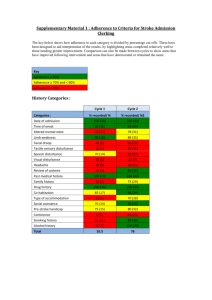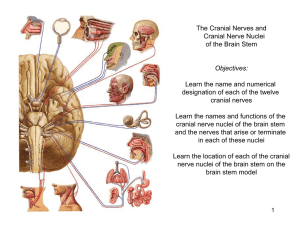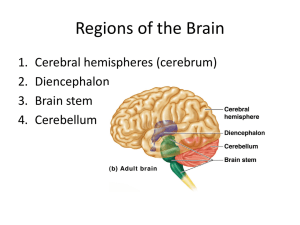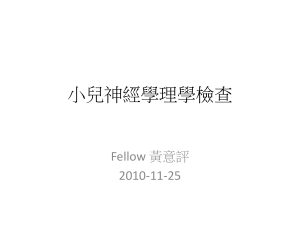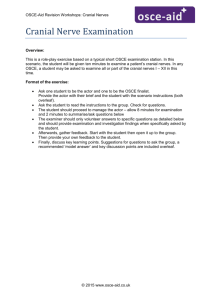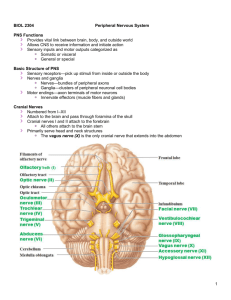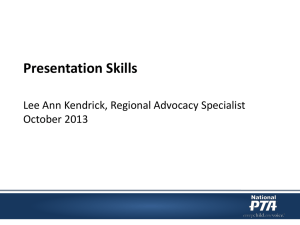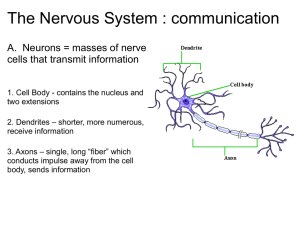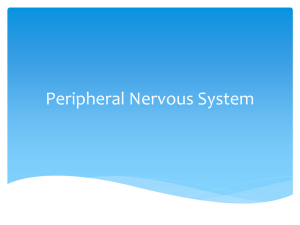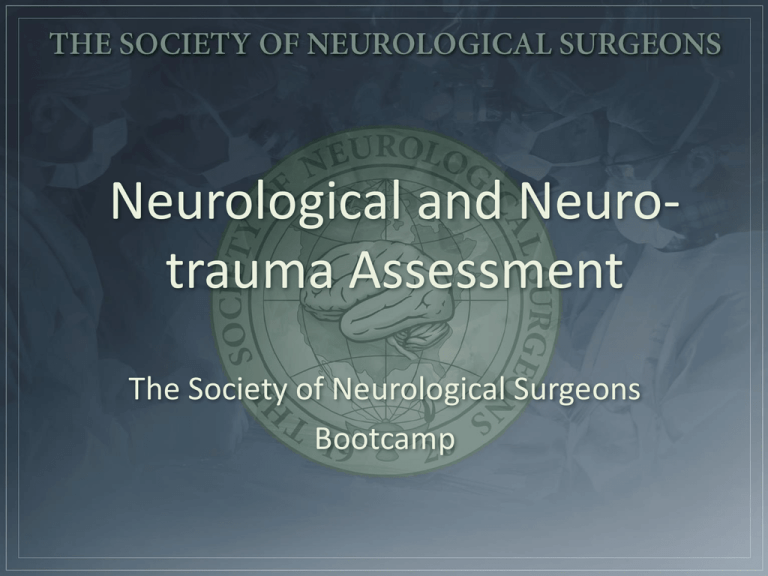
Neurological and Neurotrauma Assessment
The Society of Neurological Surgeons
Bootcamp
6 Essential Parts of a Neurologic Exam
1)
2)
3)
4)
5)
6)
Mental Status and Cognitive Function
Language
Cranial Nerves
Motor System
Sensory System
Reflexes
Assessment of Mental Status
– Level of Consciousness: (alert, somnolent,
obtunded)
– Orientation: (to time, place, examiner, situation)
– Attention span
– Mood and affect: (labile, apathetic, dysphoric,
euphoric, anxious irritable)
– Disorders of thinking and perception:
(hallucination, delusion, paranoia)
Language
• Aphasias
– Fluent (Wernicke’s) aphasia
– Non-fluent (Broca’s) aphasia
– Conduction aphasia
– Transcortical aphasias
Assessment of Cranial Nerves
• CN I (Olfactory Nerve)
– Indications for carrying out this test include frontal
headache and seizures, which might be due to an olfactory
groove meningioma.
– Smell is tested by using a non-noxious stimulus such as
soap or coffee, testing each nostril individually.
Assessment of Cranial Nerves
• CN II (Optic Nerve)
– Visual acuity, visual fields, pupillary reaction to light.
– Check for an afferent pupillary defect by using the
swinging flashlight test.
Assessment of Cranial Nerves
• CNs III, IV, and VI (Oculomotor, Trochlear, and
Abducens Nerves)
– Functions of these cranial nerves include pupillary
constriction and dilation, eye movements, and eyelid
elevation.
– Dysfunction of one or more of these functions produces
pupillary inequality (anisocoria), diplopia, or ptosis.
– The extraocular muscles work together during the act of
conjugate gaze and convergence, which are evaluated
during the examination of these cranial nerves.
Assessment of Cranial Nerves
• CNs III, IV, and VI (Oculomotor, Trochlear, and
Abducens Nerves)
– Pupils. The pupils should be examined for equality. If anisocoria exists,
one must determine which pupil is abnormal.
– Diplopia. The eyes should be moved into the extremes of gaze in the
six gaze directions that test individual muscles (superior rectus: up,
inferior rectus: down, lateral rectus: abduction, medial rectus:
adduction, inferior oblique: up and in, superior oblique: down and in).
– Ptosis. The patient should look up for 1 to 2 minutes. Ptosis due to
myasthenia gravis usually worsens during prolonged upward gaze. The
ptosis of a Horner's syndrome is usually mild and associated with
miosis
Assessment of Cranial Nerves
• CN V (Trigeminal Nerve)
– Both motor and sensory divisions of the trigeminal nerve should be
tested.
– The presence of wasting of a temporalis muscle suggests involvement
of the motor root. Jaw deviation on opening the mouth may also be
present.
– The masticatory muscles should be palpated when the patient
attempts to clench the jaws.
– The three sensory divisions of CN V.
Assessment of Cranial Nerves
• CN VII (Facial Nerve)
– The facial nerve supplies the muscles of facial expression and carries
taste sensation from the anterior two thirds of the tongue.
– Have the patient smile vigorously to assess the strength of the muscles
of the lower face, have the patient wrinkle the brow, and to squeeze
the eyes tightly together while the examiner attempts to pry them
apart.
– The lacrimal and salivatory glands are also innervated by
parasympathetic fibers that are carried in the facial nerves.
Assessment of Cranial Nerves
• CN VIII (Vestibular-Auditory Nerve)
– Rubbing the fingers together can be compared between two sides for
screening. Hearing loss can be detected with a tuning fork if it is
severe.
– The Doll’s eye maneuver is performed by quickly moving the head
from side to side and observing the movement of the globe within the
orbit.
– Comatose patient with intact midbrain and pons eyes will deviate
towards opposite direction of head turning.
– Vestibular Caloric testing is useful in confirming the presence or
absence of brainstem function in comatose patients.
Assessment of Cranial Nerves
• CN IX and X (Glossopharyngeal and Vagus Nerves)
– Cranial nerves IX and X are usually tested together. It is convenient to
think of cranial nerve IX as mainly sensory and cranial nerve X as
mainly motor.
– Testing sensation on the posterior third of the tongue and oropharynx
is examined by testing the gag reflex.
– Hoarseness is characteristic of involvement of cranial nerve X and also
occurs with lesions in the nucleus ambiguus, the origin of motor fibers
to the pharynx and larynx.
– Unilateral lesion involving CN X reveals uvula deviation.
– Bilateral lesions of the descending corticobulbar fibers can produce
pseudobulbar palsy, in which the palate elevates poorly to saying "ah"
but briskly when a gag reflex is elicited.
Assessment of Cranial Nerves
• CN XI (Spinal Accessory)
– The spinal accessory nerve supplies the ipsilateral SCM and
trapezius muscles.
– Weakness of head turning to opposite side
– Examination should include observation for muscle atrophy,
palpation and movement against resistance.
– Hemiparesis may be associated with weakness of shoulder shrug
and weakness of turning the face toward the side of the
hemiparesis.
Assessment of Cranial Nerves
• CN XII (Hypoglossal Nerve)
– The hypoglossal nerve contains only motor fibers to the ipsilateral
tongue.
– Damage to the hypoglossal nucleus or its fibers leads to tongue
atrophy, weakness, and fasciculations.
– The tongue protrudes toward the side of lesion.
Assessment of Motor Function
American Spinal Injury Association (ASIA) Motor Key
Root
Function
Muscle
C5
Elbow flexors
Biceps
C6
Wrist extensors
Extensor carpi radialis longus and
brevis
C7
Elbow extensors
Triceps
C8
Finger flexors
Flexor digitorum profundus
T1
Finger abductors
Abductor digiti minimi
L2
Hip flexors
Iliopsoas
L3
Knee extensors
Quadriceps
L4
Ankle dorsiflexors
Tibialis anterior
L5
Long toe extensors
Extensors hallucis longus
S1
Ankle plantar flexors
Gastrocnemius, soleus
Muscle Grading
Grade
Strength
0
Total paralysis
1
Palpable or visible contraction
2
Active movement, full range of motion, gravity eliminated
3
Active movement, full range of motion, against gravity
4
Active movement, full range of motion, against gravity and
provides some resistance
5
Active movement, full range of motion, against gravity and
provides normal resistance
NT
Not tested
Deep Tendon Reflexes
Examination
Localization
Effect
Biceps Tendon
C5-C6 (musculocutaneous n.)
Contraction of the biceps
muscle, Elbow flexion
Brachioradialis Tendon
C6 (radial n.)
Elbow flexion
Triceps Tendon
C6-C7 (radial n.)
Elbow extension
Patellar Tendon
L3-L4 (femoral n)
Achilles Tendon
S1-S2 (tibial n.)
Knee extension
Plantar flexion of the foot
Tendon Reflex Grading Scale
Grade
Description
0
Absent
1+
Sluggish
2+
Normal
3+
Hyperactive without clonus
4+
Hyperactive with clonus
Reflex Examination
•
•
•
•
•
Clonus
Babinski
Hoffman
Bulbocavernosus
Anal wink
Assessment of Radiculopathy
Root
Level
Distribution of Sensory
Loss
Motor Weakness
Reflex Loss
C5
Shoulder, upper arm
Shoulder abduction
None
C6
Anterior upper arm,
radial forearm, thumb
Forearm flexion
Biceps
C7
2nd , 3rd finger
Forearm extension,
wrist, handgrip
Triceps
C8
4th , 5th finger
Wrist extension,
intrinsic hand muscle
None
L4
Anterior thigh, inner
calf, foot
Knee extension
Patellar
L5
Outer calf, great toe
Foot, toe dorsiflexion
None
S1
Outer calf, foot,
posterior thigh
Knee flexion, foot
flexion
Achilles
Clinical Syndromes
• Central Cord Syndrome:
• Cervical region injury and leads to greater weakness in the
upper limbs than in the lower limbs, with sacral sensory
sparing.
• Brown-Séquard syndrome:
• Ipsilateral hemiplegia and loss of proprioceptive sensation
with contralateral loss of pain and temperature sensations
following a spinal hemisection.
• Anterior Cord Syndrome:
• Lesion causing variable loss of motor function and sensitivity
to pain and temperature; proprioception is preserved.
Clinical Syndromes
• Conus Medullaris Syndrome:
• Injury to the terminal spinal cord. Early incontinence,
perineal numbness and preserved Knee reflex.
• Cauda Equina Syndrome:
• Injury to the lumbosacral nerve roots in the spinal
canal. Asymmetric lower limb weakness, leg pain,
numbness and absent reflexes. Delayed incontinence.
Neuro-trauma Assessment
• Initial Survey
– ABCs
• Blood Pressure
• Oxygenation
– GCS
– Pupils
– Motor symmetry/strength
Neuro-trauma Assessment
Hypotension (single SBP < 90mm Hg)
•
•
Doubles mortality
Hypoxia (apnea or cyanosis, or PaO2 < 60mmHg
on ABG)
•
•
Increases mortality
Combination of both
•
•
•
Triples mortality
Increases the risk of bad outcome
Neuro-trauma Assessment
Neurogenic shock
•
Spinal cord injury above T1
•
•
Interruption of sympathetics
•
•
Loss of vascular tone (vasoconstrictors) below level of injury
• Incidence increases with injuries above T6
Parasympathetics relatively unopposed
• Bradycardia
• Lower systemic vascular resistance
• Venous pooling
Neuro-trauma Assessment
•Evidence of basal skull fractures
•Raccoon's eyes
•Battle’s sign
•CSF rhinorhea/ otorrhea
•Hemotympanum or laceration of external
auditory canal
Clinical Findings of CSF Leak
• Determining if rhinorrhea or otorrhea is due to
CSF leak:
• Clear drainage unless CSF is infected or
mixed with blood
• Patient with rhinorrhea describes salty or
metallic taste
• Collect fluid and obtain quantitative
glucose, beta2 Transferrin
• Ring sign
Neuro-trauma Assessment
•
Clinical severity is graded by GCS
• Mild, GCS 13-15
•
•
Normal to lethargic
Mildly disoriented
• Moderate, GCS 9-12
•
•
•
Lethargic to obtunded
Follows commands with arousal
Confused
• Severe, GCS 3-8
•
•
•
Comatose, no eye opening or verbalization
Does not follow commands
Motor exam: ranges from localizing to posturing


